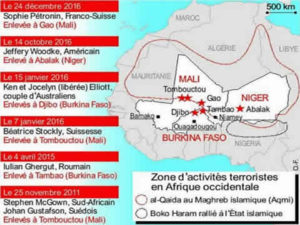
- Over the last week of February 2019, a successful Barkane operation in northern Mali may have provided the answer to questions put on this page back in July 2017 (see below). Which government or organization has facilitated the release of the two hostages and were handed over to? From which airport did they return home? Finally, who has received the ransom payment if any was paid?
- Barkane is reported to have arrested, at the end of February, a former Malian gendarme and his companion, a few hundred kilometers north of Timbuktu. A credible rumor accredits the idea that both have spoken to their captors. They may have reported important information about the hostages including the purchase of a costly property costly in one of the Sahel capitals. The amount of the ransom is not mentioned. But in Barkane, they for sure, do know.
The three coordinated terrorist attacks of 14 August (in Ouagadougou and Douenza and Timbuktu in Mali) as deadly as they were, must not hide a new development of major importance in the Sahel. A development that went unnoticed let us say due to …..the summer holidays.
The Swede Johan Gustafsson, kidnapped in Timbuktu on 25 November 2011 was freed on 26 June 2017. The South African Stephen Mc Gown, his companion of misfortune captured on the same day, was released on 27 July. On 9 August the Swede condemned the payment of ransoms to the hostage takers.
Beyond that statement, which comforts the positions of all those opposed to the payment of ransoms, the return to normal life of these two ex-prisoners does not seem to enter into any previous model of hostage release in the Sahel. Thus the question: what is new in the Sahel?
Contrary to recent practices, this time there was no formal ceremony for the handing over of prisoners to the representatives of their countries of origin. Moreover, there was no presence of the Head of State of the country that helped release of the prisoners or any official delegation of the country of the hostages to « welcome » their compatriots. No photos of the victims in local suits or a release of their thank you statements. There were also no televisions and journalists to capture the event, record the congratulations and thanks and the exemplary international cooperation that resulted in freeing the victims. Another practice has also disappeared: no prisoner, close to the hostage takers, has been officially released to justify to the public opinion the operation and « to cover » the payment of the ransoms.
In reality, the release of two long-term hostages deserves more light!
Several questions require an answer. In which country were they liberated and which government has negotiated their release? Which financial or other parties, external or internal, have been paid and by whom?
Response to these « anomalies » regarding the liberation of Johan Gustafsson and Stephen McGown must be a priority for the countries and institutions concerned by the scourge of insecurity in the Sahel. That response would also provide a powerful insight into institutional dysfunctions and other drifts (trafficking, hostage-taking, terrorism) in the region and eventually help resolve it.
In fine, the effectiveness of the much expected deployment of the G 5 Sahel troops will depend on a clear response to the new enigma.
